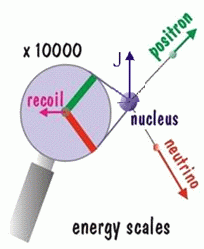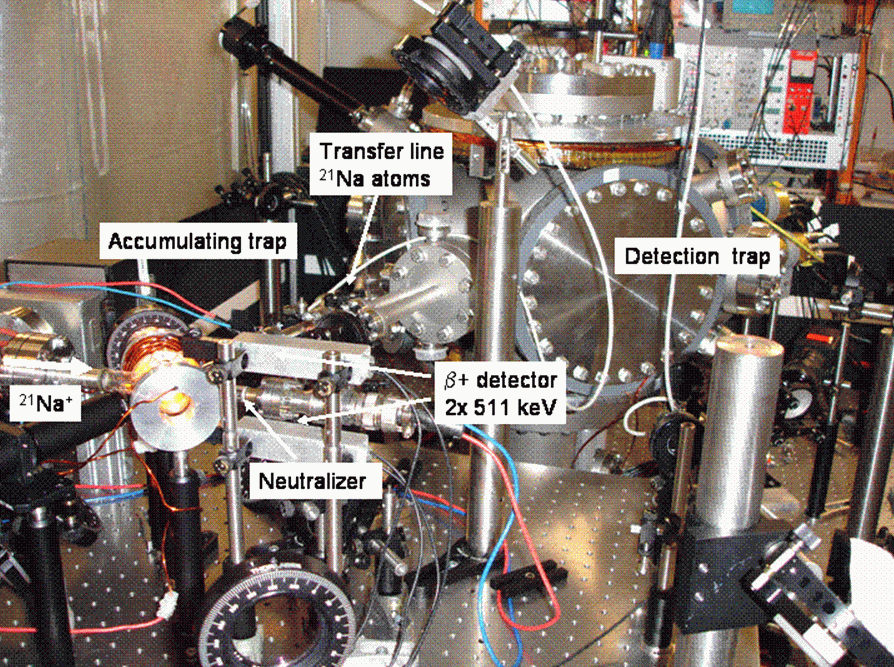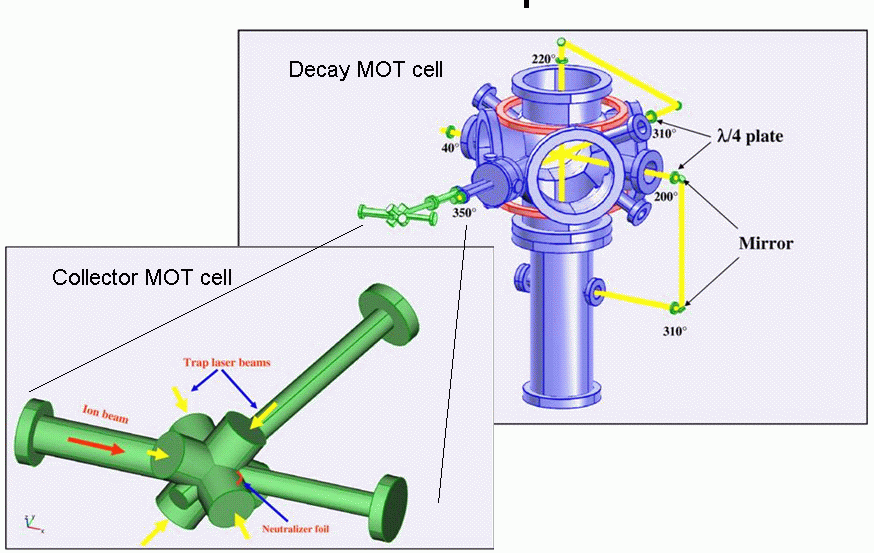Partenaires
KVI setup
The KVI atomic trapping facility is a double magneto-optical trap. The first trap contains a hot neutralizer to convert ions into atoms and to select, collect and hold radioactive isotopes/isomers. The sample can be transferred to a second trap where the actual measurement on the atom takes place. Currently it contains a setup to measure beta-neutrino correlations. The neutrino kinematics is inferred from the recoil measured with the RIMS technique (Recoil-Ion momentum spectrometer) and the beta-particle momentum measured using scintillators. Parts of the existing setup can be used to start up new measurements, e.g. on atomic parity non-conservation.
Physics case
Atomic trapping of radioactive atoms allows one to perform precision measurements by which one can search for new physics, i.e. to set new limits on the validity of the standard model. In beta-neutrino correlations one may search for scalar (S) and tensor (T) contributions to Vector and Axial vector (V-A) structure of the Weak Interaction. When the sample can be polarized the beta-decay correlation can be measured, which is odd under time reversal. Either 21Na -> 21Ne or 39Ca -> 39K beta decay can be measured, both transitions are mixed Gamow-Teller - Fermi (3/2+ -> 3/2+) transitions. Laser equipment is available for both. The actual choice depends on the status of the field when DESIR becomes available. The 39Ca case has not been studied yet and may be favorable in view of the simple nuclear structure.
 Figure 1: Schematic view of a recoil measurement
Figure 1: Schematic view of a recoil measurement
An interesting feature of SPIRAL2 is the copious production of neutron rich Cs isotopes. The fundamental measurement of the weak charge has been performed most accurately by Wieman and co-workers for 133Cs, i.e. the only stable isotope of Cs. The measurement was made by observing atomic parity non-conservation (APNC). The comparison to the Standard Model value of the weak charge required both a correct atomic and nuclear structure description. Alternative techniques to the Boulder measurement have been suggested by Bouchiat et al. and would require atomic trapping of Cs. This is technically relatively easy as only solid state lasers are required. At SPIRAL2 the systematic of the weak charge (spin independent APNC ) and the anapole moment (spin dependent) would become feasible for very long isotopic chain.
Description of setup
The setup consists of two optical tables separating the primary laser and stabilization from the actual dual MOT configuration. An impression of the current configuration is given in the figure below.

The MOT cell is a glass container with a small heated foil as neutralizer on which the beam is focused. The radioactive ion beam should be slowed down to an energy of about 1 keV. Both the neutralizer and magnetic coils can be pulsed when necessary. The MOT sample in the first cell can be transferred with a push beam to the second cell, which can be configured to perform the measurements. In this way accumulation and selection can be separated to avoid unnecessary radiation background in the measurement area.

Figure 3: Schematic view of the two MOT
Possible key experiment
![]() New limits on scalar and tensor contributions in the weak interaction.
New limits on scalar and tensor contributions in the weak interaction.
![]() New limits on time-reversal violation in beta decay.
New limits on time-reversal violation in beta decay.
![]() Systematic of atomic parity non-conservation in a long isotopic chain.
Systematic of atomic parity non-conservation in a long isotopic chain.
Contact: Hans Wilschut, Groningen